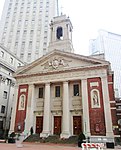Foley Square
Civic Center, ManhattanParks in ManhattanProtests in New York (state)Squares in ManhattanUse mdy dates from March 2020

Foley Square, also called Federal Plaza, is a street intersection in the Civic Center neighborhood of Lower Manhattan, New York City, which contains a small triangular park named Thomas Paine Park. The space is bordered by Worth Street to the north, Centre Street to the east, and Lafayette Street to the west, and is located south of Manhattan's Chinatown and east of Tribeca. It was named after a prominent Tammany Hall district leader and local saloon owner, Thomas F. "Big Tom" Foley (1852–1925).
Excerpt from the Wikipedia article Foley Square (License: CC BY-SA 3.0, Authors, Images).Foley Square
Foley Square, New York Manhattan
Geographical coordinates (GPS) Address Website Nearby Places Show on map
Geographical coordinates (GPS)
| Latitude | Longitude |
|---|---|
| N 40.7147 ° | E -74.0028 ° |
Address
StoryCorps
Foley Square
10007 New York, Manhattan
New York, United States
Open on Google Maps









